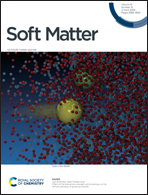Uncommon nonlinear rheological phenomenology in uniaxial extension of polystyrene solutions and melts†
Abstract
This study examines nonlinear rheological responses to uniaxial extension of two entangled polystyrene (PS) solutions and two PS melts. Several unusual characteristics are revealed. The pair of the PS solutions have the same number of entanglements per chain (because of the same concentration) but well separated effective glass transition temperatures Tg. When examined at a common effective rate of extension (e.g., the same Rouse–Weissenberg number WiR) and at a comparable distance from their respective Tg, the solution A with lower Tg, examined at a lower temperature, shows stronger stress responses when WiR > 1. At the same test temperature and a common WiR, the solution A is still found to display a stronger stress response than the solution B that is made of the same fraction of parent PS in a second solvent also made of oligomeric PS of higher molecular weight. Finally, there are two features intrinsic to each of the four PS samples. First, at the same WiR they show reduced stress level at a lower temperature. Second, at sufficiently high applied Hencky rates, they show limiting rate behavior, i.e., undergoing the same melt rupture independent of the applied rate. These remarkable rheological responses indicate major theoretical difficulties facing the subject of nonlinear extensional rheology of entangled polymers.



 Please wait while we load your content...
Please wait while we load your content...
